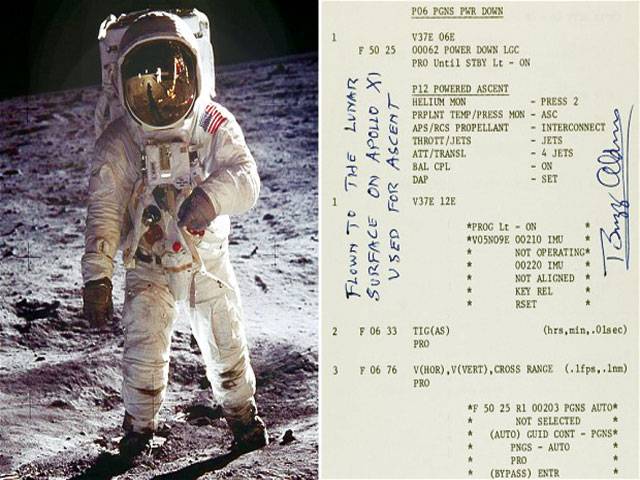BUZZ Aldrin, the Apollo 11 astronaut, is to sell the instruction sheets used during the first Moon landing. The notes were part of Aldrin's own manual used while Armstrong piloted the Lunar Module Eagle towards the Moon in 1969. Also included in the sale is a second-by-second account by Aldrin of the fraught final minutes as the Module approached the surface of the moon.
It reveals that the first words spoken on the surface were "Contact Light", spoken by Aldrin to confirm touch down. The primary guidance and navigation papers also have computer procedures on how to perform the lunar lift-off to enable the pair to leave the Moon. The papers would also have shown the astronauts how to lift off from the Moon if an emergency arose.
Aldrin is selling the sheets after a change in the law last year paved the way for Apollo astronauts to retain legal ownership of items they kept from their missions. It is thought they will raise around £60,000.
A letter by Aldrin which accompanies the sheets tells just how dramatic the famous Moon landing was. In the letter Aldrin describes the moment an alarm sounded when the astronauts were close to landing on the moon.
The craft's computer was loaded with so many tasks the alarm kept sounding - meaning the men were behind in the jobs they needed to do before they could safely land.
Aldrin's letter states: "The lunar landing was an experience I will always remember...some eight minutes into our descent engine burn, we started our most challenging part of the landing - the approach phase sequence. We were behind on flight tasks due to the distractions caused by the alarms. Neil was monitoring our instruments and the visual view out his window.
"Neil's flying tasks suddenly became more complicated because the computer was sending us into a large crater containing and surrounded by boulders.
"At about 500 feet above the lunar surface, Neil Armstrong entered the commands to manually fly Eagle to the lunar surface with computer support. He slowed the descent rate to just a few feet per second and studied the surrounding terrain. Neil asked me about our fuel status and I indicated we had eight per cent remaining. I was then able to glance outside and began to understand why the landing sequence was taking longer than planned - the craters, rocks and boulders seemed to be everywhere. "Mission Control radioed we had '60 seconds' of fuel remaining. Then '30 seconds' rang in our headsets. Neil was almost to the surface when a haze of dust was kicked up by engine exhaust. He could not see the surface and had to locate something just above the dust cloud. Finally Neil was able to see a rock that appeared fixed in the stream of dust. This gave him a surface reference. –TG
"Just as Neil placed Eagle gently on the lunar surface, I spoke the first words from the Moon: 'CONTACT LIGHT!' This was the indicator light on our control panel that told us that Eagle had touched the lunar surface. We only had about 20 seconds of fuel remaining onboard."
Matthew Haley, specialist in space history at auctioneers Bonhams, said: "Apollo 11 is pretty much the high point of the American space programme and the highlight of space exploration full stop as it was the first manned lunar landing.
"These documents have been to the Moon and back are the equivalent of Christoper Columbus's logbook. They might appeal to an institution but this market is very much dominated by private collectors.
"The cards are pretty technical so having the letter from Buzz Aldrin with them is the icing on the cake as it helps explain just how relevant the cards were.
"The key points are the printed text about the powered ascent, when they come back from the surface of the Moon after becoming the first people to step on it. "They would have been getting instructions from Mission Control throughout, hence the annotations."
The sheets will be sold by Bonhams auctioneers in New York on March 25. TG
Friday, April 19, 2024
Aldrin's 1969 guide to landing on moon for sale

20pc Discos employees involved in power theft: Minister
April 19, 2024
Five govt officials shot dead in D I Khan
April 19, 2024
Parvez Elahi’s indictment delayed again in two cases
April 19, 2024
SC suspends ECP’s re-polling order in PP-51
April 19, 2024
Hepatitis Challenge
April 18, 2024
IMF Predictions
April 18, 2024
Wheat War
April 18, 2024
Rail Revival
April 17, 2024
Addressing Climate Change
April 17, 2024
Justice denied
April 18, 2024
AI dilemmas unveiled
April 18, 2024
Tax tangle
April 18, 2024
Workforce inequality
April 17, 2024
New partnerships
April 17, 2024
ePaper - Nawaiwaqt
Advertisement
Nawaiwaqt Group | Copyright © 2024





